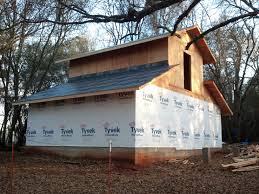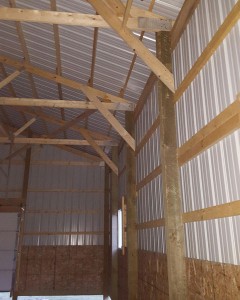How to Determine the Most Effective Weather Resistant Barrier for a Building
With more and more post frame (pole) buildings being used for residences, offices and other conditioned buildings – weather barriers (think Housewraps) have become a hot topic.
Matt Risinger wrote the article below for the Journal of Light Construction, and whilst it is directed towards residential stick frame construction, the very same rules apply for post frame.
Water hasn’t changed how it enters a house, but how we deal with it as builders certainly has. Let’s start with an oft-mentioned truism: All wall claddings leak. What we might think of as a house’s first line of defense against the elements turns out to be relatively defenseless. Regardless of your level of craftsmanship, water is going to find its way behind whatever you cover your exterior walls with—wood, masonry, metal, or vinyl.
In the not-so-distant past, when houses were not as well insulated or as tightly built as they are today, water that infiltrated behind the siding might have stained the flower-patterned wallpaper in the parlor, but chances are, the house didn’t rot.
It’s a different story with today’s tighter and more energy-efficient homes. We began to understand this in the early 2000s, when mold was discovered in buildings throughout the U.S. With the mold came rot. Home builders remedied some of the problems by paying attention to things like ventilation and source control, which they previously had the leisure to ignore. But more than a few needed to buy back new homes from disgruntled homeowners.
And it got worse: As further measures were taken to improve building airtightness and energy efficiency, even more rot and mold problems arose.
 But there are solutions. Building science has shown us what to do with water that leaks behind wall claddings. Proper installation of a housewrap—also known as a water-resistive barrier (WRB)—preferably with a rainscreen behind the wall cladding, enables us to build resilient homes that will last for generations. In this article, I will tell you what I’ve learned as a builder about keeping water away from sheathing and framing and discuss some of the good, better, and best systems currently available.
But there are solutions. Building science has shown us what to do with water that leaks behind wall claddings. Proper installation of a housewrap—also known as a water-resistive barrier (WRB)—preferably with a rainscreen behind the wall cladding, enables us to build resilient homes that will last for generations. In this article, I will tell you what I’ve learned as a builder about keeping water away from sheathing and framing and discuss some of the good, better, and best systems currently available.
ALL THAT WATER AND NO PLACE TO GO
The main reason that rot and mold didn’t substantially affect older homes is because the water that got past the leaky siding had a chance to dry. Before the days of plywood sheathing and drywall, not to mention insulation, caulking, and other airtightness measures, air flowed more freely through the building and any water that got in dried out.
Wood doesn’t rot and mold doesn’t grow when wood gets wet; it happens when the wood stays wet and can’t dry. And engineered-wood products (OSB in particular) don’t stand up to constant wetting as well as solid-wood framing and sheathing products do.
MANUFACTURER SPECS
Don’t get too hung up on a housewrap’s perm rating—the amount of water vapor that a housewrap will allow to pass through it. For cold-climate houses, a perm rating of 5 to 30 is sufficient, and in a warm climate where the vapor drive is primarily from outside to inside and the air conditioning removes the majority of water vapor, a zero perm rating is fine. In a hot, humid climate like I have, where the walls should be allowed to dry to the inside, no interior vapor barrier, such as vinyl wallpaper, should ever be used.
Capped fasteners. Some housewrap manufacturers recommend, or require, the use of a cap stapler to install their products, for the extra water resistance and holding power staples provide. We use a Stinger CH38 hand cap stapler.
Come back for tomorrow for part II of this three part series where we discuss the different weather resistant barrier options….








